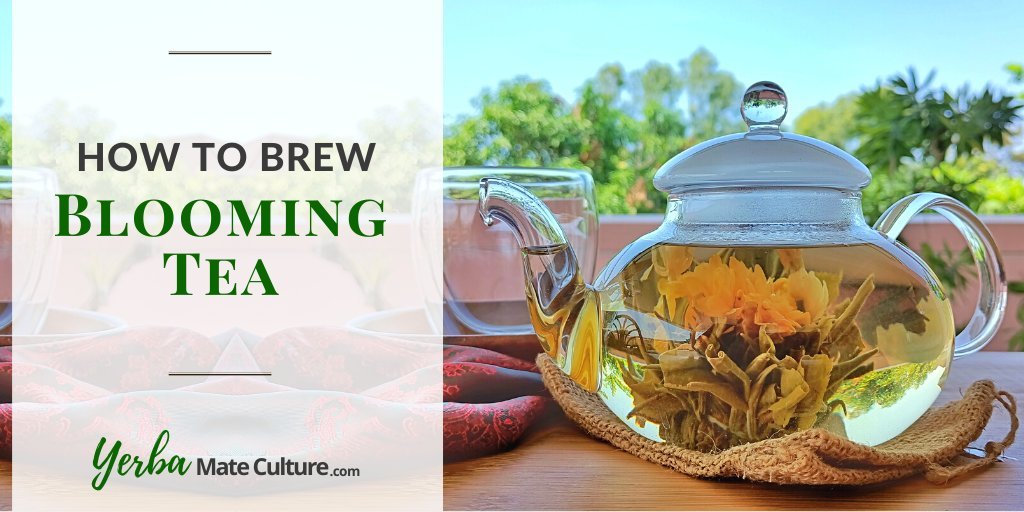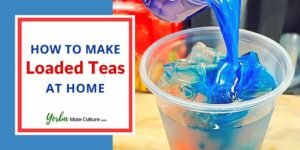Welcome to the delightful and enchanting world of blooming teas!
Whether you’re a tea aficionado or just curious about exploring the more artistic side of tea drinking, you’re in for a treat. Blooming tea, also known as flowering tea, is not just a beverage, it’s an experience – a blend of aesthetic charm and exquisite flavors that dance on your palate.
In this guide, I’ll give you step-by-step instructions for brewing blooming teas. I’ll also tell you where to buy different types of high-quality blooming teas and how to customize your tea experience further.
So, grab your favorite teapot, boil some water, and prepare to be swept away into the elegant world of blooming tea!
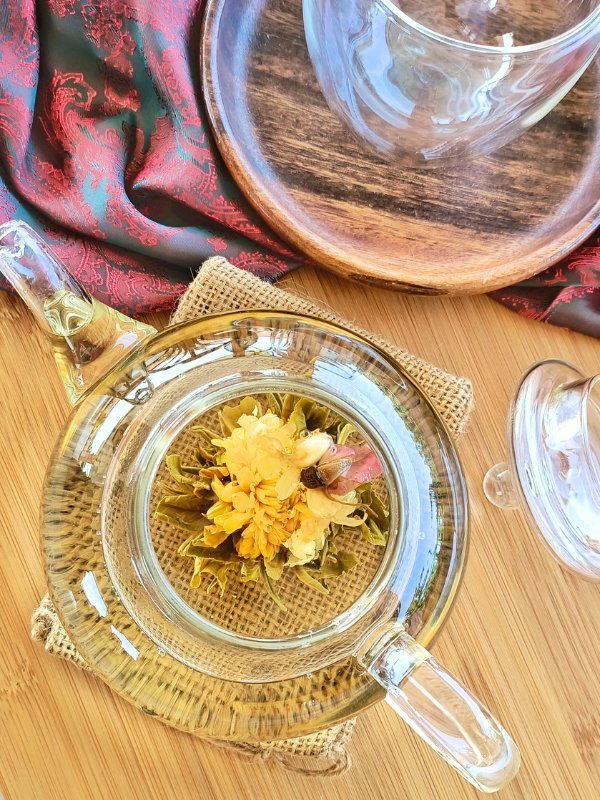
What is Blooming Tea?
Blooming tea, also known as flowering tea, is a type of tea that combines tea leaves and edible flowers. These components are skillfully hand-tied together into a compact bundle.
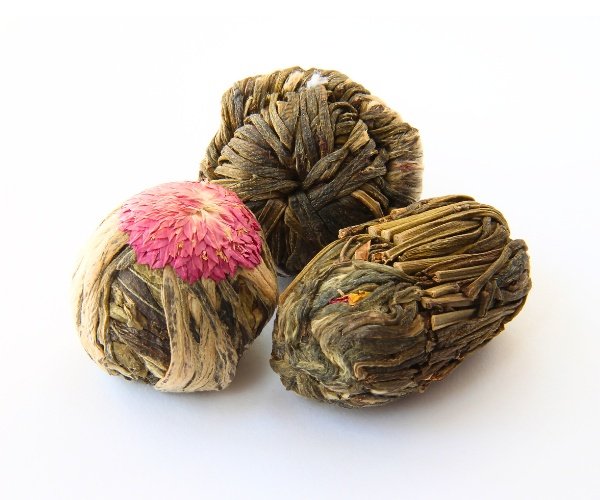
When steeped in hot water, the bundle expands and unfurls in a process that mimics a blooming flower. This not only creates a visually stunning display but also infuses the water with a unique blend of the flavors from the tea leaves and flowers.
Blooming teas are appreciated for both their aesthetic beauty and their delicate, floral taste.
As a tea enthusiast, I find that brewing blooming tea is akin to a ritual; it’s about taking a moment to slow down and appreciate the beauty and subtlety in life!
Types of Blooming Teas
Blooming teas are primarily made using the following types of tea leaves:
- Green Tea: The most commonly used base for blooming teas. Green tea leaves offer a subtle, fresh flavor that complements the floral notes without overpowering them.
- White Tea: Known for its delicate and slightly sweet flavor, white tea is sometimes used in blooming teas. It pairs well with the gentle flavors of the flowers, adding to the overall mild and elegant taste of the brew.
- Black Tea: Less commonly used, but some blooming teas might incorporate black tea for a stronger flavor.
The most common flowers used in blooming tea are chosen for their aesthetic appeal, ability to infuse well with tea leaves, and sometimes for their flavor. These include:
- Jasmine: Known for its highly fragrant aroma, jasmine is a popular choice in blooming teas, adding a subtly sweet and highly aromatic character.
- Chrysanthemum: Often used for its bright appearance and mild, slightly sweet flavor, chrysanthemum adds a lovely visual contrast and a gentle floral taste.
- Marigold (Calendula): Marigold flowers impart a slightly earthy flavor and are known for their vibrant orange or yellow petals, creating a striking visual display.
- Lily: Lilies are appreciated for their large, beautiful blooms and add a slightly sweet, floral taste to the tea.
- Osmanthus: This flower adds a unique apricot-like fragrance and a mild, sweet flavor to the tea, making it a delightful ingredient.
- Globe Amaranth: These bright purple or pink flowers don’t impart much flavor but are chosen for their stunning color and shape.
- Rose: Rose petals can be used for their classic, romantic aesthetic and their delicate, slightly sweet flavor.
- Hibiscus: Hibiscus flowers add a tart flavor and a deep red color, offering both visual appeal and a zesty taste profile.
Each of these flowers contributes not only to the visual beauty of blooming tea but also introduces subtle flavor nuances, making each brew a unique experience.
Where to Buy Blooming/Flowering Tea?
The easiest way to get some high-quality blooming tea is to order it from Amazon.
Here are my favorite products:
- Teabloom Flowering Tea – 12 Unique Varieties
- Numi Organic Flowering Tea Gift Set (6 Tea Blossoms & Glass Teapot)
You can also find blooming teas in some specialty tea shops.
How to Brew Blooming Tea
Now that you have your blooming tea, it’s time to start brewing! Preparing blooming tea is a simple yet graceful process.
Follow these step-by-step instruction to brew blooming tea:
- Select the Right Teaware: Use a clear glass teapot or a large glass mug. The transparency allows you to fully appreciate the blooming process of the tea.
- Heat the Water: Heat fresh, filtered water to just before boiling (around 80-85°C or 176-185°F). Avoid using boiling water as it can scorch the tea leaves, affecting the flavor and the unfolding process.
- Pre-Warm the Teapot/Mug: Pour some hot water into the teapot or mug, swirl it around, and then discard. This step ensures that your brewing vessel is warm, which helps the tea to steep properly.
- Place the Blooming Tea Ball: Gently place one blooming tea ball in the bottom of your teapot or mug. Be careful not to drop it in, as this can damage the delicate structure.
- Pour the Hot Water: Slowly pour the hot water over the tea ball, filling the teapot or mug. Pouring slowly helps the tea ball to retain its shape and bloom evenly.
- Steep and Watch: Allow the tea to steep and watch as the tea ball begins to unfurl. This usually takes about 5-10 minutes. The tea is ready when the flower is fully bloomed.
- Enjoy the Tea: Once the tea has steeped and the flower is fully open, it’s time to enjoy your cup. Pour the tea into glasses or cups, being careful to leave the flower in the pot for visual enjoyment.
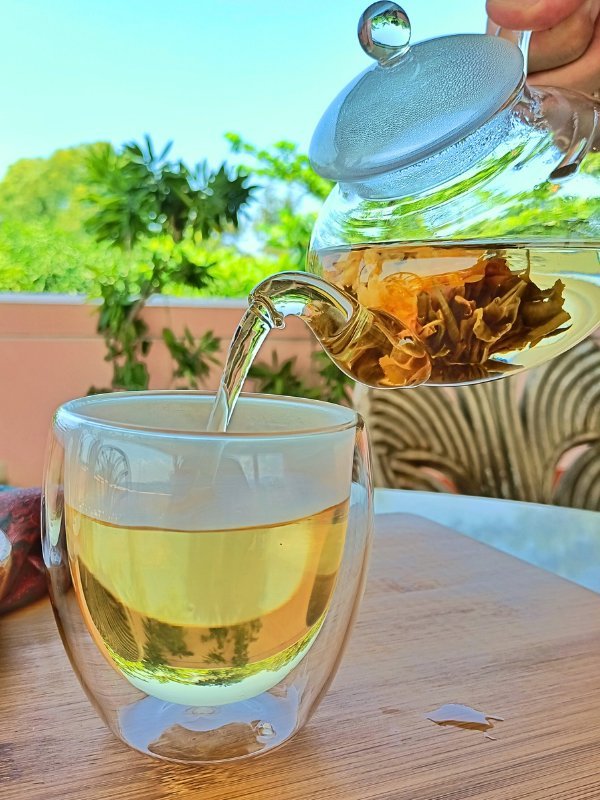
Blooming tea can often be steeped multiple times. Simply add more hot water to the pot after your first serving and enjoy the flavors again.
Remember, part of the charm of blooming tea is in watching the flower unfurl, making the brewing process not just about taste, but also about the visual spectacle. Each blooming tea is unique, so the steeping time and the flower’s appearance can vary.
Enjoy the experience!
Tips & Variations
- Enhance the Flavor with Additives: While blooming tea has a delicate flavor, you can enhance it by adding honey, a slice of lemon, or a dash of sugar. These additives can complement the floral notes without overpowering the tea’s natural essence.
- Pair with Light Snacks: Blooming tea pairs beautifully with light snacks such as macarons, shortbread cookies, or fruit slices. The mild flavor of the tea complements rather than competes with these foods.
- Experiment with Different Blooming Teas: There are many varieties of blooming tea, each with different flowers and tea leaf combinations. Experiment with different types to find your favorite flavor profiles and visual displays.
- Chill for Iced Blooming Tea: After brewing and enjoying a hot cup, you can chill the remaining tea in the refrigerator to make iced blooming tea. It’s a refreshing variation, especially during warmer weather, and allows the floral notes to take on a slightly different character.
Blooming Tea FAQ
Does blooming tea have caffeine?
Yes, most blooming teas contain caffeine as they are typically made from green or black tea leaves. However, the caffeine content is usually lower than that of regular green or black tea.
Can blooming tea be reused?
Yes, a single blooming tea ball can be used for multiple infusions. The flavor might be milder after the first steeping.
What does blooming tea taste like?
The taste can vary, but generally, it has a delicate and slightly floral flavor. Often with the mild, refreshing characteristics of green or white tea.
How long can you keep a blooming tea ball?
Before brewing a blooming tea ball, you can store it in a cool, dry place for up to a year. After brewing, it’s best enjoyed within the day.
Does drinking blooming tea have any health benefits?
Blooming tea can have similar benefits to green or white tea, such as antioxidants. However, it’s more valued for its aesthetic appeal than its health benefits.

